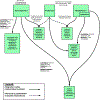Systems Biology-Based Investigation of Host-Plasmodium Interactions
- PMID: 29779985
- PMCID: PMC7028355
- DOI: 10.1016/j.pt.2018.04.003
Systems Biology-Based Investigation of Host-Plasmodium Interactions
Abstract
Malaria is a serious, complex disease caused by parasites of the genus Plasmodium. Plasmodium parasites affect multiple tissues as they evade immune responses, replicate, sexually reproduce, and transmit between vertebrate and invertebrate hosts. The explosion of omics technologies has enabled large-scale collection of Plasmodium infection data, revealing systems-scale patterns, mechanisms of pathogenesis, and the ways that host and pathogen affect each other. Here, we provide an overview of recent efforts using systems biology approaches to study host-Plasmodium interactions and the biological themes that have emerged from these efforts. We discuss some of the challenges in using systems biology for this goal, key research efforts needed to address those issues, and promising future malaria applications of systems biology.
Keywords: Plasmodium; host–pathogen interaction; malaria; omics; systems biology.
Copyright © 2018 Elsevier Ltd. All rights reserved.
Figures


Similar articles
-
Vive la Différence: Exploiting the Differences between Rodent and Human Malarias.Trends Parasitol. 2020 Jun;36(6):504-511. doi: 10.1016/j.pt.2020.03.008. Epub 2020 Apr 16. Trends Parasitol. 2020. PMID: 32407681 Free PMC article. Review.
-
Cellular and molecular interactions between the apicomplexan parasites Plasmodium and Theileria and their host cells.Parasite. 2008 Sep;15(3):211-8. doi: 10.1051/parasite/2008153211. Parasite. 2008. PMID: 18814683 Review.
-
Organoids for Liver Stage Malaria Research.Trends Parasitol. 2020 Feb;36(2):158-169. doi: 10.1016/j.pt.2019.12.003. Epub 2019 Dec 14. Trends Parasitol. 2020. PMID: 31848118 Review.
-
Implications of imaging malaria sporozoites.Trends Parasitol. 2008 Mar;24(3):106-9. doi: 10.1016/j.pt.2007.11.009. Epub 2008 Feb 14. Trends Parasitol. 2008. PMID: 18280209
-
Recent advances in the parasitology of malaria.Trans R Soc Trop Med Hyg. 1989;83 Suppl:3-9. doi: 10.1016/0035-9203(89)90595-6. Trans R Soc Trop Med Hyg. 1989. PMID: 2696157 Review.
Cited by
-
A global Anopheles gambiae gene co-expression network constructed from hundreds of experimental conditions with missing values.BMC Bioinformatics. 2022 May 9;23(1):170. doi: 10.1186/s12859-022-04697-9. BMC Bioinformatics. 2022. PMID: 35534830 Free PMC article.
-
Zoonotic Malaria: Non-Laverania Plasmodium Biology and Invasion Mechanisms.Pathogens. 2021 Jul 13;10(7):889. doi: 10.3390/pathogens10070889. Pathogens. 2021. PMID: 34358039 Free PMC article. Review.
-
Functional genomics of simian malaria parasites and host-parasite interactions.Brief Funct Genomics. 2019 Sep 24;18(5):270-280. doi: 10.1093/bfgp/elz013. Brief Funct Genomics. 2019. PMID: 31241151 Free PMC article. Review.
-
Putative pathogen-selected polymorphisms in the PKLR gene are associated with mycobacterial susceptibility in Brazilian and African populations.PLoS Negl Trop Dis. 2021 Aug 27;15(8):e0009434. doi: 10.1371/journal.pntd.0009434. eCollection 2021 Aug. PLoS Negl Trop Dis. 2021. PMID: 34449765 Free PMC article.
-
Diversity, distribution, and drivers of Polychromophilus infection in Malagasy bats.Malar J. 2021 Mar 20;20(1):157. doi: 10.1186/s12936-021-03696-0. Malar J. 2021. PMID: 33743716 Free PMC article.
References
-
- Baird JK (2009) Malaria zoonoses. Travel Med Infect Dis 7 (5), 269–77. - PubMed
-
- WHO (2016) Malaria World Report.
-
- Wanjek C (2011) Systems Biology as Defined by the NIH. The NIH Catalyst 19 (6).
Publication types
MeSH terms
Grants and funding
LinkOut - more resources
Full Text Sources
Other Literature Sources
Medical

